2024 Moto Guzzi Stelvio Ride Review
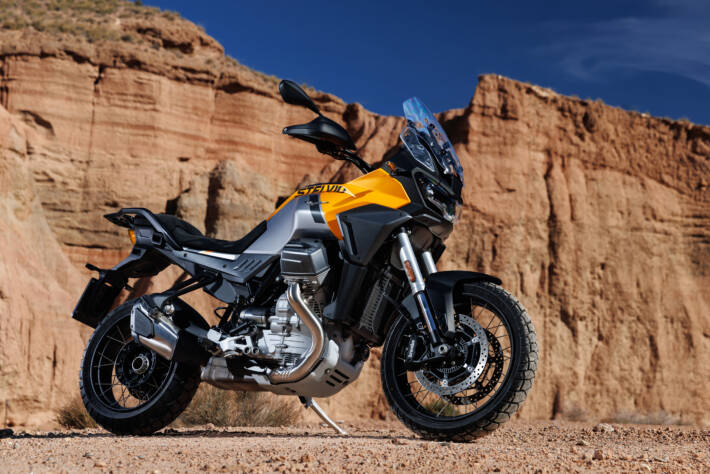
The old Moto Guzzi Stelvio was a bit off the pace in terms of performance. But for 2024, the Italian brand has released an all-new machine with the latest high-tech V100 Mandello motor. Our man Alan Dowds went to Almeria to check it out.
Moto Guzzi’s adventure tourer has one of the most evocative names in adventure biking, named after the Stelvio Pass in Italy. That mountain route goes from southern Switzerland into the very northern part of the Lombardy region at the top of Italy.
 2024 Moto Guzzi Stelvio
2024 Moto Guzzi Stelvio
At almost 10,000 feet, it’s the second-highest paved mountain pass in the whole of the Alps – so the road is pretty spectacular, with 75 hairpin bends (or 48, or 60, depending who you believe) and stunning views. It’s like a Mecca for motorcyclists.
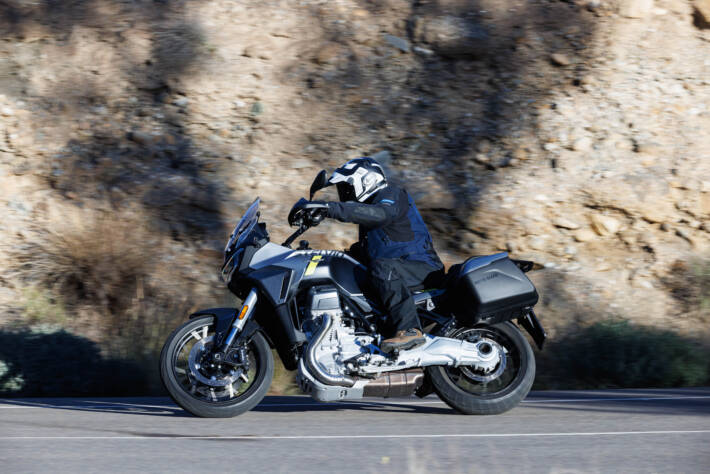
 2024 Moto Guzzi Stelvio
2024 Moto Guzzi Stelvio
A great name for an adventure-touring motorcycle then, and it’s the moniker that Moto Guzzi chose for its heavyweight offroad-styled machine back in 2007. Using the old air-cooled eight-valve engine from the firm’s Griso 1200 roadster, it stuck with traditional Guzzi elements: a transverse V-twin layout, with the cylinders sticking out each side at 90°, which allows the other Guzzi essential – shaft final drive – to be easily packaged.
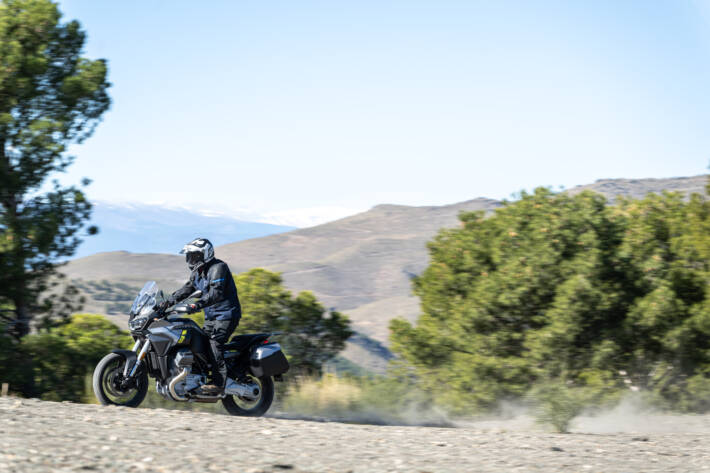
 2024 Moto Guzzi Stelvio
2024 Moto Guzzi Stelvio
The rest of the original Stelvio followed the typical big dual-sport recipe: wire-spoked wheels and chunky tyres, adventure style bodywork, hard luggage, and on the NTX version, a massive 32 litre fuel tank.
It worked well enough, but the old-tech air-cooled engine, with its high-cam cylinder heads working the valves, was heavy – indeed the whole bike was a bit chunky, ending up weighing more than 270kg wet in NTX form (albeit with that 32 litre tank and hard luggage).
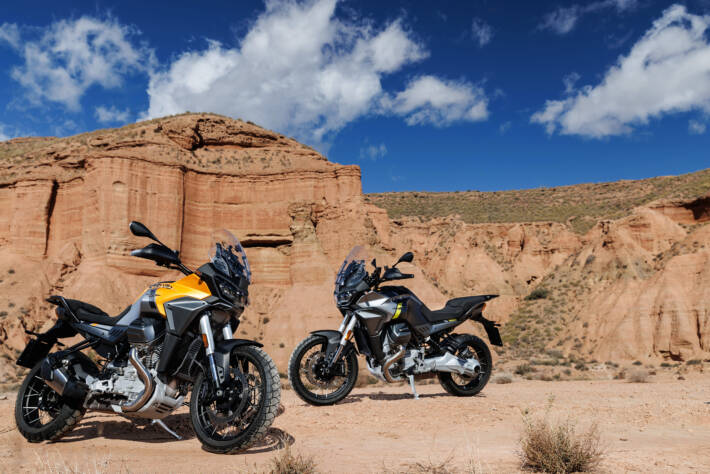
 2024 Moto Guzzi Stelvio
2024 Moto Guzzi Stelvio
The competition was red-hot though, and has got even hotter since. Guzzi dropped the old Stelvio in 2016, and has gone without a full-sized adventure tourer – until now. Last year’s V100 Mandello debuted the firm’s latest engine design: a proper 1,042cc water-cooled unit, with DOHC four-valve heads and vertical inlet and exhaust ports, which also weighed less than the previous 1200. And it’s a modified version of that engine which powers the new Stelvio.

 2024 Moto Guzzi Stelvio
2024 Moto Guzzi Stelvio
We went to Almeria in Spain for a sunny ride on the new bike. Moto Guzzi had organised a full day out on the machines around the , taking in a bit of motorway, some fast sweeping ‘A’ roads, and a load of super-twisty mountain roads – including what’s known as the ‘small Stelvio’ route near Velefique.
After the briefing, I nip out sharpish to grab a bike with panniers, and get myself acquainted with the new bike. First impressions are decent enough (though the key doesn’t work on one pannier case).
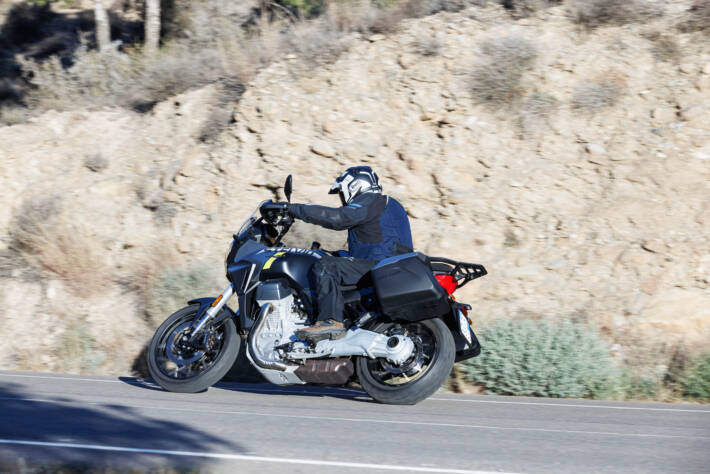
 2024 Moto Guzzi Stelvio
2024 Moto Guzzi Stelvio
The Stelvio has a sensible seat height for my stumpy frame (5ft 8in, 29-inch inside leg), the bars are a nice width, and when I lift it up off the sidestand, the weight distribution is spot-on.
There’s no top-heavy feeling at all, which you sometimes get on taller big-bore machines like this. I’m a little disappointed that I can’t connect my iPhone to the neat colour dashboard though. You can do this – but only with an optional Bluetooth module, which the test bikes don’t have. A first world, 2024 problem for sure…
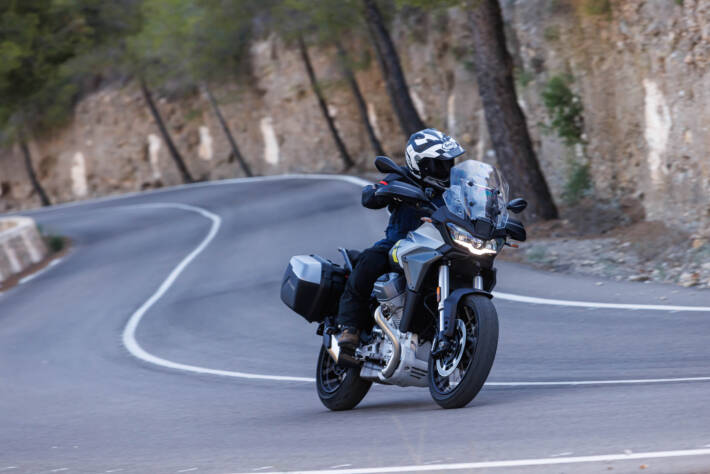
 2024 Moto Guzzi Stelvio
2024 Moto Guzzi Stelvio
We set off from the hotel, following the lead rider, and I’m settling in nicely. The new motor is smooth, thanks to the 90° layout, and a balancer shaft, and the fuelling is good. I have a quick swap between the riding modes, which is easy to do once you work out the buttons, and the Sport mode feels a bit sharper, with a more sudden throttle action, while the Road, Touring and Rain modes are all suitably softer.
Onto the motorway, where I get a chance to sample the cruise control – again, easy enough to operate once you work out the slightly non-intuitive controls. The cruise lever doubles up as a riding mode change button when the cruise is off, and you need to press and hold to activate the cruise.
I spend a few miles trying the ‘active’ radar-assisted cruise control, but quickly realise that this bike doesn’t have it (it’s an optional fitment).
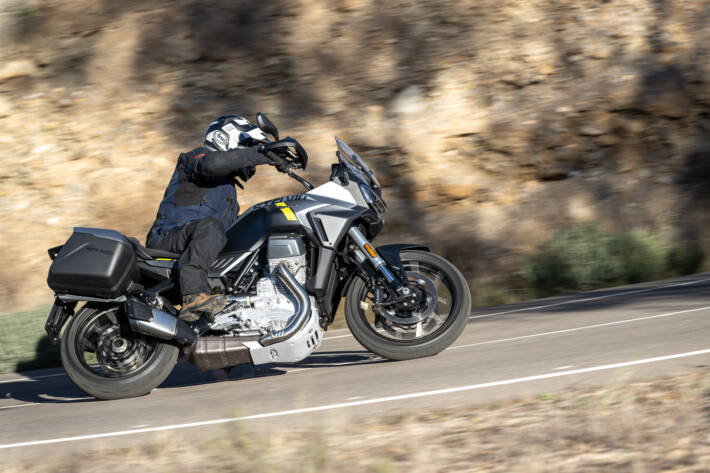
 2024 Moto Guzzi Stelvio
2024 Moto Guzzi Stelvio
The radar sensors are still there, but only work as a warning system, flashing up a warning on the dash and beeping away if you get too close to the vehicle in front. I’m not convinced of its worth to be honest: riding a bike is nothing like sitting in a car for me, and I’m pretty sure I can spot when I’m about to ride into a truck in front.
And if I can’t, then I should probably be having a rest stop instead of relying on a piece of electronics…
The rear-facing radar is a bit more useful: Guzzi has engineered it to work as a Blind Spot and Lane Change warning, so if you’re about to pull out into the fast lane and don’t notice a car or bike coming up fast, there are lights in the mirrors and dashboard to warn you. Not a game-changer, but a worthwhile extra, especially on the Spanish motorway where the locals don’t hang about in the fast lane.

 2024 Moto Guzzi Stelvio
2024 Moto Guzzi Stelvio
The final toys to play with are the up/down quickshifter, which works well with a lovely rort on the auto-blipper when you change down an extra cog, and the electric windscreen.
This has a fair degree of adjustment, though some taller riders complained of buffeting at the highest setting: I wasn’t so bad, but if you’re lanky then a higher screen might be worth investigating. Factory heated grips and seat are also an option – but not needed in today’s 20 degree Andalusian sunshine of course.
The lead rider has turned off the motorway now though, and it’s time for action stations. It’s a Saturday morning, and the mountain roads are fairly busy with locals in cars and trucks, elderly tourists enjoying a low-season break, and enthusiastic cyclists, pedalling up the serious climbs singly, and in larger packs.
You really need to be on your toes, and ready for whatever appears round the next blind hairpin bend.
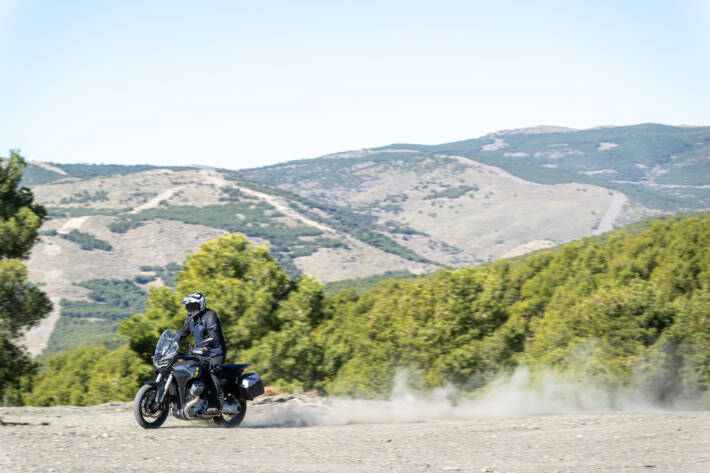
 2024 Moto Guzzi Stelvio
2024 Moto Guzzi Stelvio
Passing a sharp-looking peloton on a twisty downhill section isn’t for the faint-hearted: they’re hitting 40mph plus and not shy about taking up all the road. I’m having a pretty tough time truth be told: the Stelvio doesn’t feel very happy at these antics, with the front end in particular seeming a little unbalanced.
It should all be working well: Guzzi has chosen a 19-inch rim on purpose for better road manners, and the Michelin Anakee tyres are top-end kit. When we stop, one of the other riders reckons that the compression damping is a bit soft, making the front dive too much on braking, and that seems plausible.
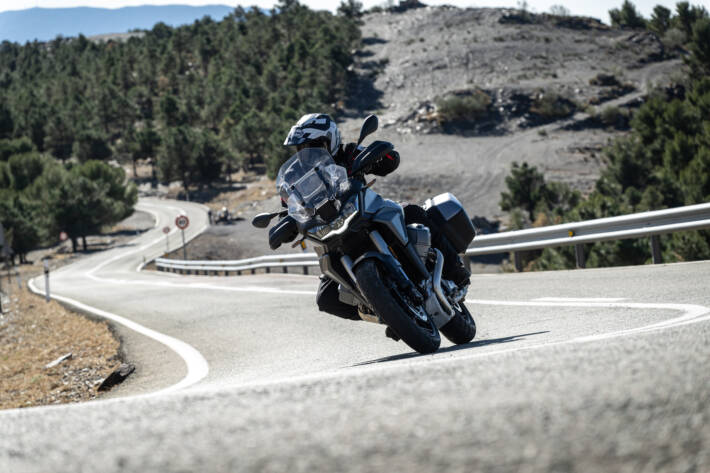
 2024 Moto Guzzi Stelvio
2024 Moto Guzzi Stelvio
By not opting for a ‘funny front end’ like BMW’s Telelever, or electronic semi-active suspension (or both), the Stelvio is back in the realms of long-travel suspension that’s soft enough for mild off-roading, but is maybe a bit soft for hard road riding – and the fork only has preload and rebound adjustment.
As it is, the front suspension lets the bike down a little in dynamic terms when pushing hard – I reckon that an electronic semi-active setup, even as an option, would lift the whole bike up a level.
Having said all that, we were riding just as hard later on in the day, and the bike felt much better as I adapted to the handling, so it’s maybe not a big issue. And the rest of the chassis works well: the brakes are great, with the four-piston Brembo radial calipers packing a powerful punch, loads of feel, and ample feedback from those Michelin tyres.
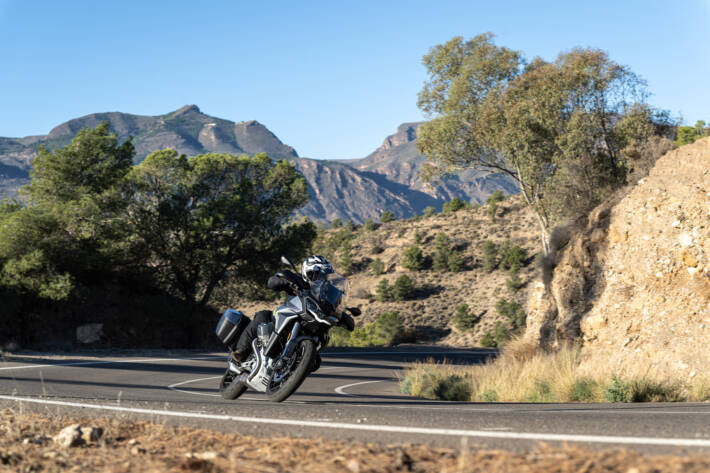
 2024 Moto Guzzi Stelvio
2024 Moto Guzzi Stelvio
There’s good ground clearance as you’d expect, and despite the lack of any clever parallelogram rear suspension linkage, the shaft drive doesn’t affect the chassis. Speaking to the Moto Guzzi tech man, he reckons they don’t need one, with the long swingarm, high-quality rear shock and stiff frame all helping counteract any ill-effects.
The press pack also speaks of the balancer shaft reducing reverse torque somehow, without further explanation. The result is a shaft drive setup that belies the simple appearance of its construction – good work Guzzi engineers!
You’ll notice I’ve not said too much about the engine so far, which is probably good and bad. Mostly good though: the engine is definitely a well-developed, modern piece of kit, that runs smoothly, has decent performance, and even sounds good from the rider’s perch (especially on hard downshifts with the autoblipper brapping away).
It’s strong enough to wheelie off the gas easily in lower gears with the traction control turned off too.
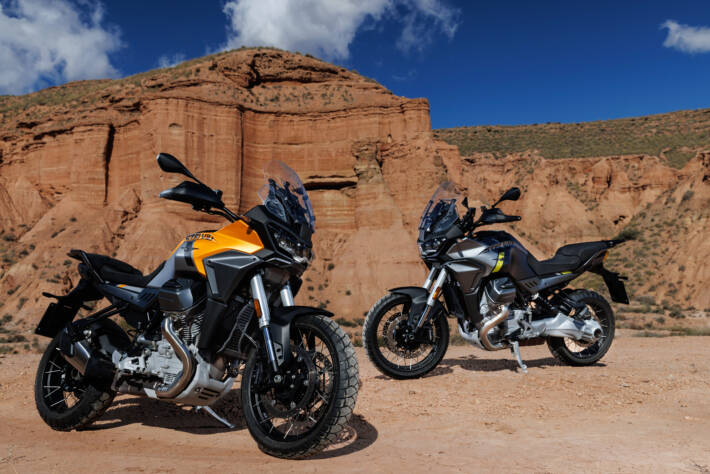
 2024 Moto Guzzi Stelvio
2024 Moto Guzzi Stelvio
But there were a few times on the twisty mountain roads where I wanted a bit more, either in terms of low-down urge, or screaming top end. There’s a nice bit of grunt in the upper-midrange, but you need to keep the gearbox tapping away to stay in that fairly narrow sweet spot of really strong drive.
No massive hardship on the launch: when you’re in the mood for a proper blast, then getting into the zone with frantic up- and down-changes is perfectly fine.
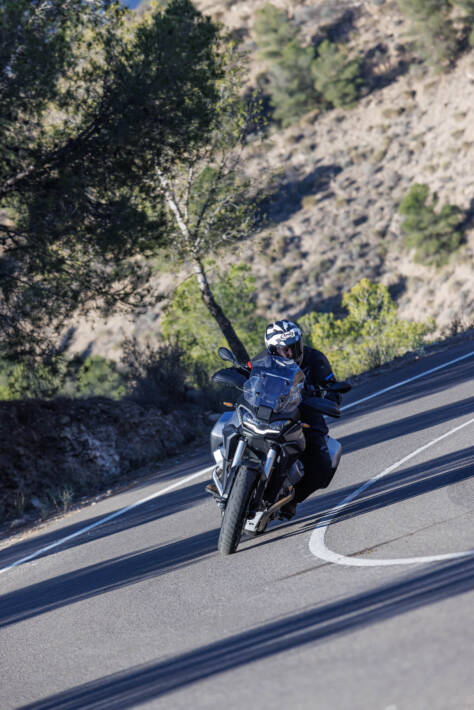
 2024 Moto Guzzi Stelvio
2024 Moto Guzzi Stelvio
I just wonder how it will feel when you’re two-up, with a load of luggage, at the end of a long day’s touring, trying to make progress on a narrow road with lots of slower traffic. That’s when the effortless grunt of something like a Ducati Multistrada V4, KTM 1290 Super Adventure or BMW S1000 XR makes a difference – but those are very different bikes of course.
Conclusion
I enjoyed my Spanish day out on the Stelvio a lot. It’s a well-thought-out upper-middleweight adventure tourer, with a high spec, and classy styling. If you want a shaft drive bike in the 900-1,100cc dual sport class then it’s the only option, and design choices like the 19” front rim and 21 litre tank all make it a solid road touring option (the off-road pretentions are just that of course).
Add in the evocative Moto Guzzi heritage, plus that unique transverse V-twin engine, and you’ll have a recipe that’s spot-on for the firm’s fans.
For the rest of the market though, it’s perhaps not so clear-cut, simply because the competition is so very strong – Honda’s Africa Twin, Triumph’s Tiger 900 range and the BMW F900 GS have all moved on in the past couple of years. The Stelvio can still hold its own in this company – and is well worth a test ride if you’re interested in this sector.
TECH FEATURES
ENGINE
Transverse 90° V-twin with DOHC four-valve cylinder heads based on the V100 Mandello engine, with a few tweaks. There’s a new slipper clutch design, and a rejigged gearbox with optional quickshifter, while the sump has been redesigned for more ground clearance. Finally the new engine meets the Euro 5+ emissions regs for 2025-on.
FRAME
Similar to the Mandello V100 unit, but with strengthened tubes, and altered geometry for the new role. Guzzi claims 20 per cent more stiffness, thanks to four front engine mounting points instead of two. The steering head is also wider with more bracing. Riding position is tweaked, and there’s more capacity for rider pillion and luggage.
The swingarm pivot area is also beefed up on the engine/transmission unit, and the swingarm casting itself is 2mm thicker (up from 5mm to 7mm on the V100), all to suit the extra rigours on an adventure machine.
SUSPENSION
Sachs kit up front: 46mm USD front forks with preload adjusters and a rebound damping adjuster on one leg. The rear shock is by KYB and has a dual-spring setup, direct operation with no linkage, and rebound/preload adjustment, including a handy remote knob for the preload. There’s no optional electronic suspension fitment – though the Guzzi folk did say it’s a possible future development if the demand is there.
BRAKES/WHEELS/TYRES
Brembo four-piston monobloc calipers up front with radial mounts, 320mm discs, Brembo master cylinder and steel hoses. Rear brake has a single 280mm disc with twin-piston Brembo caliper. Continental cornering ABS setup which works with the Marelli IMU ECU.
Wheels are tubeless wire-spoked parts, with Michelin Anakee tyres, 120/70 19 front and 170/60 17 rear.
ELECTRONICS
Ride-by-wire throttle and IMU-equipped Magneti Marelli 11MP ECU (as used on the Aprilia RSV4 1100) gives a full-featured riding aids package. There are five riding modes: Tour, Rain, Street, Sport, and Off-Road. Each mode offers three different engine maps, four levels of traction control, three levels of engine brake and two levels of ABS control.
The settings can also be customised, allowing riders to fine-tune the parameters to match their individual preferences. Tour mode is tailored for long-distance travel, and engine braking is set to medium, power delivery is progressive, at level 2 out of 3, and the traction control is set at level three out of four.
Rain mode also has medium engine braking and the softest power delivery, with traction control set at maximum.
In Road mode, the engine braking is at a medium level, power delivery (MGCM) is progressive (level 2 out of 3), and traction control (MGCT) is configured at the second level out of four.
And Sport mode has engine braking on minimum, power delivery is at its sharpest and traction control is the least intrusive (level one out of four). The ABS calibration enables very firm braking.
Finally, there’s an Off-Road setting, for dirt use only. Engine braking and power delivery are on maximum, and traction control and ABS are finely tuned for off-road with minimal traction intervention, and ABS only on the front wheel.
In addition, you can turn off the traction control (across all riding modes) and ABS on both wheels (in Off-Road mode only) for added flexibility and control.
ACCESSORIES
Loads of factory options: for touring there’s hard panniers (30l left 29l right), a 52l or 37l top box, touring windscreen, soft luggage, heated grips and seats, lower and higher rider seats. Other bolt-ons include engine bars, LED lights, up/down quickshifter, Bluetooth phone link, active cruise control and more.
2024 Moto Guzzi Stelvio specs
Engine:
Liquid-cooled 90° transverse V-twin cylinder. Double overhead camshaft with finger rocker arms and four valves per cylinder
Displacement
1042 cc
Bore and stroke
96 x 72 mm
Compression ratio
12.6:1
Maximum power
115 CV (84,6 kW) at 8,700 rpm
Torque
105 Nm (10,7 kgm) at 6,750 rpm
Fuelling
Electronic fuel injection; dual Ø 52 mm throttle bodies and ride by wire
Fuel tank capacity
21 litres (reserve 3.5 litres)
Homologation
Euro 5+
Fuel consumption (WMTC cycle)
5.1 l/100 km
TRANSMISSION
Clutch
Wet multi-disc clutch with slipper clutch and hydraulic control and integrated clutch slave
Gears
6-speed gearbox
Primary transmission
Straight-geared, gear ratio: 31/48 (1.548)
Primary transmission
Cardan shaft drive: gear ratio: 12/38 (3.166)
Control management
3 engine maps (MGCM), 3 levels of engine brake control (MGFM), 4 levels of traction control (MGTC), cruise control. 5 Riding modes (Touring, Rain, Road, Sport, Off-Road)
Chassis
Frame
Tubular high-strength steel frame
Front suspension
Front suspension Sachs telescopic hydraulic upside-down fork, Ø 46 mm, adjustable spring preload and rebound hydraulics
Front wheel travel
170 mm
Rear suspension
Aluminium single-sided shock absorber left side, adjustable in spring preload with knob and rebound hydraulics
Rear wheel travel
170 mm
Brakes
Front: dual 320mm stainless steel floating discs, Brembo radial-mount calipers with 4 opposed pistons and metal braided hose
Rear: 280mm stainless steel disc, Brembo floating 2-piston caliper.
Continental ABS with cornering function
Front rim
Tubeless spoked 3.0″ x 19″
Rear rim
Tubeless spoked 4.5″ x 17″
Front tyre
Radial tubeless 120/70 – R19″
Rear tyre
Radial tubeless 170/60 – R17″
DIMENSIONS
Length
2195 mm
Width
945 mm
Wheelbase
1520 mm
Seat height
830 mm
Rake
25.6°
Trail
116.4 mm
Dry weight
222 kg
Kerb weight *
246 kg
* Weight with bike ready to ride, with all operating fluids and 90% fuel






